Being physically active is a key contributor to good health. Physically active people have a lesser chance of getting many chronic diseases including Cardiovascular disease, Diabetes Stroke, various types of cancer, Anxiety and Depression.
An active lifestyle involves engaging in activities that make you more mobile, like going for a 30 minute walk, taking the stairs to your office, or even dancing.
Some physical activity is better than none.
The more you move, the more your health benefits. Often, patients are overwhelmed by the thought of an intense exercise regimen (i.e training for a marathon, HIIT training, hours at the gym), so it’s important to emphasize that while intensive exercise can be beneficial, some movement that can fit into your daily lifestyle is also still beneficial to your health.

It can involve walks around the park or the neighborhood, light jogging, dancing and taking the stairs. If you haven’t been active in a while, it’s actually best to begin by taking it slow.
Living a sedentary lifestyle means that you engage yourself in little or no physical activity.
It is easy to understand why so many people today live sedentary lives. So many jobs these days require people to sit at a desk or stand in one place for hours at a time. And with the number of hours the average American is working, it may seem impossible to make time to go to the gym.

The US Department of Health & Human Services indicates that being sedentary has become a health hazard, resulting into chronic health conditions such as obesity, type-2-diabetes, heart disease and some types of cancer. Sedentary behavior also contributes to early death.
According to the same source, a sedentary lifestyle also has a negative impact on mental health. This particular study showed that sedentary behavior and lack of physical activity led to a risk of developing mental health disorder.
What was shocking was that this study included data from 110,152 participants which found a link between sedentary behavior and an increased risk of depression.
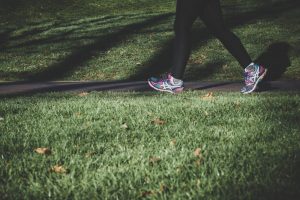
The goal here is good health. Current guidelines push for at least 150 minutes of moderate-intensity exercise per week. Studies also show that essentially the more you exercise, the lower your risk for chronic diseases.
Keep in mind that intensity is relative and will depend on the amount of effort it takes you to do a particular activity. A level 5 for one person, may be a level 10 for another.
According to multiple medical studies and sources mentioned below, this is the amount of exercise you really need to reap optimal health benefits:
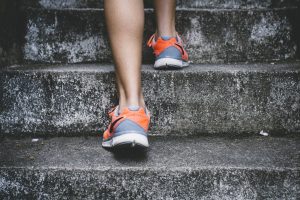
Examples of Moderate Intensity Exercise (as advised by the CDC):
Walking briskly (2.5 miles per hour or faster)
• Recreational swimming
• Bicycling slower than 10 miles per hour on level terrain
• Tennis (doubles)
• Active forms of yoga (for example, Vinyasa or power yoga)
• Ballroom or line dancing
• General yard work and home repair work
• Exercise classes like water aerobics
Examples of Vigorous Intensity Exercise (as advised by the CDC):
• Jogging or running
• Swimming laps
• Tennis (singles)
• Vigorous dancing
• Bicycling faster than 10 miles per hour
• Jumping rope
• Heavy yard work (digging or shoveling, with heart rate increases)
• Hiking uphill or with a heavy backpack
• High-intensity interval training (HIIT)
• Exercise classes like vigorous step aerobics or kickboxing
Walking is probably a favorite form of exercise to many people as it is not strenuous and it can easily be incorporated into our daily routines.
Walking may seem like it is not enough to maintain good health but experts argue different.
Walking is a great way to stay in shape, improve and maintain your health.
According to Health Harvard, if you walk for as little as thirty minutes a day, you can increase your muscle power and endurance, reduce excess body fat, strengthen bones and improve cardiovascular health.

If you are worried about risks associated with other forms of exercise, you can take up walking as part of your work out. It is safe, it can be done at your own pace and doesn’t require any equipment.
People who have been sedentary for a long time, like the elderly, can take up walking as a form of exercise.
Patients commonly talk about knee pain, back pain, or old injuries as a limiting factor in their ability to exercise. While these issues may limit the types of exercise that you can do, it should not stop you from all exercise as the exercise may actually help you feel better.
It’s important to discuss these issues with your doctor as he/she can suggest what may be the best option for you.
Here are some examples:
1. swimming – this is great for your heart, however does not benefit bone strength
2. walking –
3. elliptical training
4. biking
5. rowing
6. water aerobics
7. yoga – intensity levels can vary depending on the type of yoga being performed
8. pilates
9. tai chi – great for balance
Before exercising, your body needs to make adjustments. These adjustments help the body in the following ways:
According Sports Medicine experts Woods K, Bishop P, Jones E. from their book Warm-up and Stretching in the Prevention of Muscular Injury. 8
Warm ups serve to initiate these adjustments gradually. Warming up helps the body reduce unnecessary fatigue and injuries, which may occur when you don’t warm up.
The secret to a good exercise session is the warm up. How can you warm up effectively? A warm up session should include light movements that increase you heart rate and breathing like jogging on the spot, walking, cycling or stretching.
Stretching is done after a warm up. Stretching can also be done during a warm up. Stretching during a warm up can include slow, controlled circular movements at key joints such as the shoulders but it shouldn’t be overdone as this overworks the muscles.
You can also engage your muscles in a static stretch. This involves gently stretching the muscle and holding it in that position for approximately 10-30 seconds.
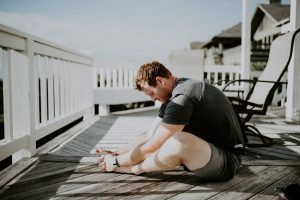
Most consider this to be the safest method of stretching. It is recommended to stretch the muscle groups you will be using during your work out.
Cooling down is a method of slowing down your activity level gradually. Cooling down does the following:
For an effective cool down, perform light exercises for 5-10 minutes like slow jogging or walking you may also stretch.
Strength training does not only increase muscle mass, it also increases your bone strength and improves posture. The goal should be 2 (or more) days a week.
Most people might think that in order to gain muscle, you have to lift heavy weights but there are alternatives to gaining muscle without using equipment.
Classes such as barre classes, yoga, and Pilates utilize primarily body weight exercises for muscle toning. Push-up and pull-ups are examples of exercises that can be done from the comfort of your home.
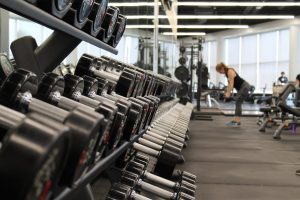
For those who don’t have access to a gym, free weights are another option for exercises that can be done at home.
Keep in mind, that if you are new to lifting weights, you will likely benefit from a trainer to ensure that you are utilizing proper posture and technique to reduce the risk of injury and to obtain maximum benefit from the exercise.
Remember to train all of your muscle groups so as to create a balance in your body. Having a muscle group that is more developed or less developed than another may lead to injuries during workouts. 9
You should start at a pace that you are comfortable with, then gradually pick up the pace until you are walking briskly.
If you are currently inactive, start by walking 5 minutes a day. You can add about 2-3 minutes to your walking time each week.
Once you achieve 30 minutes a day, work on increasing your pace. Optimal physical exercise will increase your heart rate.
The table below shows a two week walking schedule from the National Heart, Lung, and Blood Institute. 10

| Week | Warm-up | Brisk walking | Cool down |
| 1 | 5 minutes | 5 minutes | 5 minutes |
| 2 | 5 minutes | 7 minutes | 5 minutes |
| 3 | 5 minutes | 9 minutes | 5 minutes |
| 4 | 5 minutes | 11 minutes | 5 minutes |
| 5 | 5 minutes | 13 minutes | 5 minutes |
| 6 | 5 minutes | 15 minutes | 5 minutes |
| 7 | 5 minutes | 18 minutes | 5 minutes |
| 8 | 5 minutes | 20 minutes | 5 minutes |
| 9 | 5 minutes | 23 minutes | 5 minutes |
| 10 | 5 minutes | 26 minutes | 5 minutes |
| 11 | 5 minutes | 28 minutes | 5 minutes |
| 12 | 5 minutes | 30 minutes | 5 minutes |
Make it fun! Most of us already have a long list of things to do. The last thing we need is another line on our “to-do” list.
For those with young children, have a dance party, play soccer, go for a family walk, play tag. You are much more likely to stick to something when you’re having fun!
If you have a long work day, try to incorporate short bursts of exercise throughout your day. For instance, taking the stairs, parking at the end of the parking lot to get a few extra steps, walk a couple of laps around the building you work at.
You may find that it helps break up your day, freshens your mind, and gets you ready to work more effectively.

To maintain your active lifestyle, you may opt to:
Everyone looks forward to group activities. Doing activities in groups distracts your mind keeping you from thinking of fatigue.

Walking in groups may result in walking for very long distances without you even noticing it.
Group activities that can motivate you include; group classes, work out clubs, group walking, and dog walking.
The National Athletic Trainers’ Association recommends choosing shoes that are comfortable with a closed toe.
The shoes should be athletic. Dr. Michael Roizen says that you should choose shoes that are made specifically for your chosen exercise program.
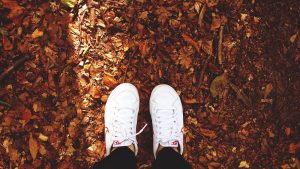
Choose shoes that provide good balance to your feet and ankles. Shoes should be replaced immediately they start to show signs of wear and tear.
If you engage in aerobics or activities that involve jumping and running, have good shoes as you are more prone to leg and ankle injuries.
Shoelaces should be replaced regularly as they stretch when washed, hence losing their support.
Setting goals for your activities will motivate you to work towards achieving set goals. You may want to reduce fat and increase muscle or someone may want to increase their stamina.
Having a calendar will help you stay organised on your activities for each day.
1. http://www.ajpmonline.org/article/S0749-3797(14)00567-4/pdf
2. https://www.hsph.harvard.edu/nutritionsource/staying-active/
3. Thorp AA, Owen N, Neuhaus M, Dunstan DW. Sedentary behaviours and subsequent health outcomes in adults: a systematic review of longitudinal studies, 1996-2011. Am J Prev Med. 201;412:207-15
4. hhs.gov/fitness/resource-center/facts-and-statistics/index.html
5. http://ajh.oxfordjournals.org/content/16/8/629.long
6. https://jamanetwork.com/journals/jamainternalmedicine/fullarticle/2212267
7. http://www.health.harvard.edu/staying-healthy/walking-your-steps-to-health
8. Woods K, Bishop P, Jones E. Warm-up and Stretching in the Prevention of Muscular Injury. Sports Medicine 2007; 3712:1089-99
9. American Academy of Orthopaedic Surgeons: ” Starting a Strength Training Program”
10. https://newsnetwork.mayoclinic.org/discussion/get-walking-with-this-12-week-walking-schedule/
11. Dr. Michael Roizen, MD https://www.sharecare.com/health/fitness-footwear/type-shoes-should-wear-workout
12. Physical Activity- Staying Motivated [online], Better Health Channel, Department of Health Victoria
13. https://journals.plos.org/plosone/article?id=10.1371/journal.pone.0154075
14. http://www.cancer.org/healthy/eat-healthy-get-active/acs-guidelines-nutrition-physical-activity-cancer-prevention.html
15. https://health.gov/paguidelines/second-edition/pdf/Physical_Activity_Guidelines_2nd_edition.pdf#page=55
16. https://annals.org/aim/fullarticle/710792/encouraging-patients-become-more-physically-active-physician-s-role?searchresult=1
IF YOU ARE IN THE UNITED STATES AND ARE EXPERIENCING A MEDICAL EMERGENCY, DIAL 911 OR CALL FOR EMERGENCY MEDICAL ASSISTANCE. THE INFORMATION FOUND AND GENERATED FROM THIS WEBSITE (THE “WEBSITE”) INCLUDING BUT NOT LIMITED TO THE TEXT, IMAGES, LINKS, AUDIO, VIDEO, EMAILS, EBOOKS OR OTHER FORMATS IS STRICTLY FOR YOUR GENERAL INFORMATION ONLY. THIS WEBSITE DOES NOT OFFER ANY SPECIFIC MEDICAL ADVICE FOR YOU AND NOTHING ON THE WEBSITE IS INTENDED TO CONSTITUTE PROFESSIONAL ADVICE FOR MEDICAL DIAGNOSIS OR TREATMENT. YOU SHOULD NOT RELY ON INFORMATION RECEIVED VIA THIS WEBSITE FOR MEDICAL, LEGAL OR FINANCIAL DECISIONS. ALWAYS CONSULT WITH AN APPROPRIATE PROFESSIONAL FOR SPECIFIC ADVICE RELATED TO YOUR SITUATION. FOR MORE INFORMATION PLEASE READ OUR FULL TERMS AND CONDITIONS BY CLICKING HERE.